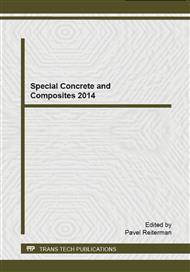[1]
Założenia narodowego programu rozwoju gospodarki niskoemisyjnej, 2011.
Google Scholar
[2]
W. Kozioł and P. Kawalec. Kruszywa alternatywne w budownictwie. Nowoczesne Budownictwo Inżynieryjne, 4:34--37, 2008.
Google Scholar
[3]
Krajowy plan gospodarki odpadami 2014, 2011. UCHWAŁA Nr 217 RADY MINISTRÓW.
Google Scholar
[4]
M.A. Glinicki. Tendencje rozwojowe technologii betonu. Przeglad Budowlany, 78:24--30, 2007.
Google Scholar
[5]
B. Zając and I. Gołębiowska. Ewolucja technologii recyklingu betonu. Inżynieria i Aparatura Chemiczna, 5:134--135, 2010.
Google Scholar
[6]
B. Zając and I. Gołębiowska. Nowoczesne metody recyklingu betonu. Inżynieria i Aparatura Chemiczna, 5:136--137, 2010.
Google Scholar
[7]
K. McNeil and T. H.K. Kang. Recycled concrete aggregates: A review. International Journal of Concrete Structures and Materials, 2013.
Google Scholar
[8]
RILEM TC 121-DRG. Specifications for concrete with recycled aggregates, 1994.
Google Scholar
[9]
F. Agrela, P. Alaejos, and M.S. De Juan. 12 - properties of concrete with recycled aggregates. In F. Pacheco-Torgal, V.W.Y. Tam, J.A. Labrincha, Y. Ding, and J. de Brito, editors, Handbook of Recycled Concrete and Demolition Waste, Woodhead Publishing Series in Civil and Structural Engineering, pages 304--329. Woodhead Publishing, 2013.
DOI: 10.1533/9780857096906.2.304
Google Scholar
[10]
M.N. Fardis. Innovative materials and techniques in concrete construction. Springer, 2012.
Google Scholar
[11]
Cz. Wolska-Kotańska. Właściwości i zastosowanie kruszywa z recyklingu betonu. Magazyn Autostrady, 3, 2005.[12] A. Golda and A. Król. Drugie życie betonu. Budownictwo, Technologie, Architektura, 4:44--47, 2006.
Google Scholar
[13]
Sasha Achtemichuk, Justin Hubbard, Richard Sluce, and Medhat H Shehata. The utilization of recycled concrete aggregate to produce controlled low-strength materials without using portland cement. Cement and Concrete Composites, 31(8):564--569, 2009. Sustainability of Civil Engineering Structures - Durability of Concrete.
DOI: 10.1016/j.cemconcomp.2008.12.011
Google Scholar
[14]
A.R.M. Ridzuan, M.A. Fauzi, E. Ghazali, M.F. Arshad, and M.A.M. Fauzi. Strength assessment of controlled low strength materials (clsm) utilizing recycled concrete aggregate and waste paper sludge ash. In Humanities, Science and Engineering (CHUSER), 2011 IEEE Colloquium on, pages 208--211, Dec 2011.
DOI: 10.1109/chuser.2011.6163718
Google Scholar
[15]
S. Naganathan, K.N. Mustapha, and H. Omar. Use of Recycled Concrete Aggregate in Controlled Low-Strength Material (CLSM). Civil Engineering Dimension, 14(1), 2012.
DOI: 10.9744/ced.14.1.13-18
Google Scholar
[16]
American Concrete Institute. ACI 229R-99 Controlled Low-Strength Materials, 1999.
Google Scholar
[17]
National Ready Mixed Concrete Association. Recommended Guide Specification for CLSM (Flowable Fill).
Google Scholar
[18]
W. Kubissa. Samozagęszczajace sie materiały małej wytrzymałości. Inżynieria i Budownictwo, 10(2013):525--529, 2013.
Google Scholar


